| Volume
97
Mid-Summer/Mid-Sea - July 2003
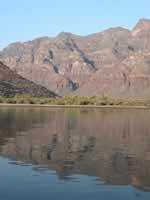 July
2003 will, in my mind, forever be Spectra watermaker month. On
the first of July, as we motored south to Juncalito to position
ourselves for the upcoming fireworks show, we got the radio
call
we had been waiting a month for. Some kind soul had picked
up the package containing our new watermaker membrane from Downwind
Marine in San Diego and brought it to Puerto Escondido. July
2003 will, in my mind, forever be Spectra watermaker month. On
the first of July, as we motored south to Juncalito to position
ourselves for the upcoming fireworks show, we got the radio
call
we had been waiting a month for. Some kind soul had picked
up the package containing our new watermaker membrane from Downwind
Marine in San Diego and brought it to Puerto Escondido.
Our beloved Spectra
watermaker has, for four hardworking years, provided us with
over 11,000 gallons of great fresh water, extracted
by the miracle of reverse osmosis from the seas we sail through.
In March Don attended Spectra’s Tech School in San Francisco
so that he would feel confident that he could keep our system operating
anywhere in the world. Ironically, when we “unpickled” the
watermaker in May after our long marina stay in Mazatlán,
we discovered that the membrane had gone into shock. Despite Don’s
schooling and despite a flurry of emails back and forth to Spectra,
nothing we tried could get our water quality back down to where
it should be. This was not a terrible shock, because we had figured
we were approaching the reasonable life expectancy of the membrane
anyway and had planned to put in a new one in the fall, especially
if we continued on schedule to depart for the South Pacific. We
had to get one a few months sooner than planned.
You may remember, however,
that we were in an emotional rush to get out of Mazatlán and back to Baja, and no way were we
hanging around to get one shipped in before we left. This meant
we had to cruise juggling water tanks for a month. We continued
to make water for general use in one 45-gallon tank, whilst in
the other two we conserved quality drinking water. This, of course,
is how many people cruise, so it was less a matter of hardship
than one of attention, and it was a valuable reality check. We
were pleased to find we hadn’t lost the ability to conserve
when we had to. However, we were pretty happy to get the new membrane
installed.
About the same time,
another of our cruising cronies from last summer – Jerry of Mirador – hooked back up with our
group, and he was having some trouble with his watermaker. Before
he knew it, Don was making his first service call. Then, a week
or so later, we were called to divert to meet up with another friend
from last summer who also had problems to diagnose. These three “jobs” (no
charge) took up a lot of Don’s time and attention and cut
severely into his hunting, reading and napping time. On the other
hand, he probably couldn’t have arranged a better scenario
for cutting his teeth as a roving tech rep.
Meanwhile, our gang – T2,
Lady Galadriel, Ryokosha and Mirador – put
together a quintessential Gringo picnic to celebrate the home country
Independence Day. Can we say cholesterol?! Onion and cheesy bean
dips (and sashimi) for starters; cheeseburgers on the grill (with
mushrooms), potato salad, Cole slaw, homemade baked beans, and – following
a break for the pyrotechnics from the beach – peach pie with
ice cream.
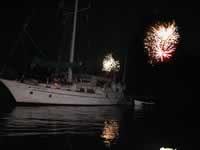  
The ice cream
is a story in itself. Jerry of Mirador started it by mentioning
he had an
ice cream maker on board, but he didn’t
have the power to run it! With our generator, we did, but then
he couldn’t find all the parts and pieces. Emails flew back
and forth to his wife (at the time in San Francisco) trying to
locate them. By the time the parts were found, it turned out to
be too late to chill the bowl down in our freezer. But Jerry and
Paul (Ryokosha) were set on ice cream and Lisa had made the pie,
so the guys hitched into Loreto and returned with two half gallons – somewhat
more than required for “a la mode.”!!!! We had the
leftovers in our freezer for weeks! But these are the little adventures
that highlight a cruiser’s life!
After the Fourth, we tried sailing southward to Bahia Candeleros
where we had met up with Lady Galadriel last year. On that occasion
this anchorage was calm and appealing, with lots of chocolate clams
plus some great fishing around the Candeleros islets. This year,
the wind came up during the night to a steady 25-30 knots from
the west continuing right into the day. Nobody slept well with
the boats pitching and the rigging shivering. It seems that in
certain weather conditions, when, ironically, there are calm conditions
of the Pacific side of Baja, that air get sucked through a notch
in the mountains to blow like the bejeezus in Candeleros! We had
a great sail out of the bay, but a mere 5-6 miles to the north,
there was no wind at all.
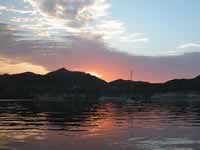 Our next stop was Marquer,
an anchorage I have mixed feeling about as it was on a dive from
here last summer that I got the bends!
However, this year it was calm with clear water, and we made the
best of the snorkeling and gathering activities that we could.
One afternoon we had the best of many dolphin shows we’ve
enjoyed this summer. A pod splashed and frolicked around us all
one afternoon. Our next stop was Marquer,
an anchorage I have mixed feeling about as it was on a dive from
here last summer that I got the bends!
However, this year it was calm with clear water, and we made the
best of the snorkeling and gathering activities that we could.
One afternoon we had the best of many dolphin shows we’ve
enjoyed this summer. A pod splashed and frolicked around us all
one afternoon.
From Marquer we broke
away from our buddies to Bahia Ballandra where Don’s second watermaker “job” awaited him.
Ballandra, however, was excruciatingly hot and miserable. The air
was hot and the water was hot, so snorkeling was no relief, unless
you dove below the thermocline, where, of course, you couldn’t
stay long enough! For the first time in Mexico I was truly sick
from the heat! Despite it, Don got the afflicted watermaker up
and running. From Ballandra we escaped back around the north end
of Isla Carmen for a reunion dinner in Vee Cove with Lourae and
Randy of Pizazz, folks we’d traveled with in Colombia. I
do think Vee Cove is one of my favorite places in the Sea, with
its Swiss cheese cliffs, steady wind and resident dolphins. Lourae
and Randy had been tucked up there for weeks and, in fact, stayed
there another two after we left.
We would have liked
to linger, but just about this time our summer plans experienced
the first of several major changes, and again
it was watermaker related. This time, however, the person wanted
to BUY a Spectra watermaker, and he wanted Don to do the installation…in
San Carlos. Back across the Sea on the mainland side, San Carlos – with
its two marinas and two boatyards – is the main place Mexican
cruisers leave their boats for the worst of the summer heat and
hurricane season. Indeed, our pals Lady Galadriel and Ryokosha were headed there around the end of the month, just the time this
guy wanted us there! So, instead of lingering, we hurried north
to catch back up with our friends.
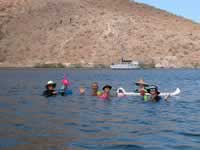 The group’s next major stop was our third visit to Bahia
Concepcion. Bahia Concepcion is a 21-mile long, nearly land-locked
bay running parallel to the Sea just south of Mulege. It is a very
popular spot with campers and RV’ers, and the string of coves
dimpled into the semicircular shoreline of Coyote Bay are lined
with vacation homes and palapas. Its appeal is understandable,
as it is a very beautiful area. It is, however, uncomfortably hot
in summer. The Amgios spent a lot of time in the water. The group’s next major stop was our third visit to Bahia
Concepcion. Bahia Concepcion is a 21-mile long, nearly land-locked
bay running parallel to the Sea just south of Mulege. It is a very
popular spot with campers and RV’ers, and the string of coves
dimpled into the semicircular shoreline of Coyote Bay are lined
with vacation homes and palapas. Its appeal is understandable,
as it is a very beautiful area. It is, however, uncomfortably hot
in summer. The Amgios spent a lot of time in the water.
Despite the heat, we
stayed at anchor in Santispac three days. Lisa had just finished
a travelogue on Baja called Miraculous Air by C.M. Mayo (University of Utah Press—ISBN 0-87480-740-9;
highly recommended!) in which the author made a day trip in this
area to see ancient cave paintings. There are a string of cave
painting sites (600!) in Baja’s very remote central mountains
that feature giant figures in red and black created by a long forgotten
people, one of the mysteries of which is how the artists managed
to paint so high over their heads. (See “Drawn from Prehistory”,
Smithsonian, May 2002.) The site near Mulege is the most accessible,
and we determined we would try to take the same excursion. Unfortunately,
it was a weekend, and the connection with a guide didn’t
get made until Monday morning, whereupon we decided his price was
too high and the plan was regretfully aborted! It probably saved
our lives. An inland road trip in that heat would have to have
been sheer lunacy. Perhaps we’ll catch it on the return trip
in the fall, although quite honestly, after reading Mayo’s
book, I feel like I’ve BEEN there.
Although our nights
in Santispac were sweaty and restless, our daytimes were not
wasted. Thanks to the group momentum, we sought
out and found two of the sights for which Concepcion is known,
both of which we’d missed last year: an arroyo full of petroglyphs
and one of a string of hot springs. The petroglyphs, once we located
them, are just a little dubious. Located awfully close to the highway
behind Playa el Burro, the cluster of carvings into the rocks suggests
that not all of them are of ancient origin. Sadly, it’s hard
to guess which, if any, might be the real thing. On the other hand,
if in fact some of it is a variation on modern graffiti, it is
impressive that the “artists” have stuck with largely
natural motifs: turtles, fish, birds, etc. as opposed to “Juan
loves Maria.” We were as much intrigued by the bell-like
tonality of some of the boulders, on which one could actually play
a tune! The hot spring we finally located was in the corner of
a beach in the northernmost cove of Playa Concepcion. Someone had
dammed up a pool to catch the heat that trickled down the sand
from a small spring. Although a hot tub was the last thing we needed
just then, we gave it the obligatory sit! Probably very popular
in the winter months!
 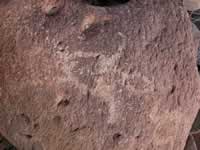 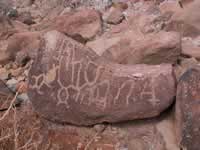
The other highlight
of our short stay was a long dinghy ride to snorkel at Islas
Guapa and Bargo. At the former we found clear
water revealing craggy overhangs and lots of fish around the tiny
islet off its southern end. At Isla Bargo, however, we scored big
time finding thousands of calico scallops lying about on the bottom
in 8-15 feet of water. Unlike the huge rock scallops that cement
their bottom shells to rock, the calico scallops are no more than
two inches across, look just like the Shell Oil logo, and are free
swimming! Should you pick one up, it may try to jet out of you
hand. Should you lay several out on a table, say, to open them
for their meat, they will chatter away like those mechanical dentures
that used to be sold as wind-up toys! 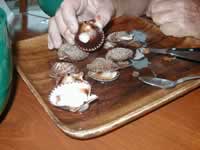 Should you eat some, you
will enjoy a seafood of the highest delectability, only surpassed
(according to the Joy of
Cooking) by Chesapeake bay scallops. We know this, because we enjoyed
scallops at Ray’s, the wonderful beachside restaurant in
Santispac, where last October I was given a truly great birthday
party. Okay, the truth is out. You now know the true reason we
put up with so many miserable nights sleep…two dinners at
Ray’s. Should you eat some, you
will enjoy a seafood of the highest delectability, only surpassed
(according to the Joy of
Cooking) by Chesapeake bay scallops. We know this, because we enjoyed
scallops at Ray’s, the wonderful beachside restaurant in
Santispac, where last October I was given a truly great birthday
party. Okay, the truth is out. You now know the true reason we
put up with so many miserable nights sleep…two dinners at
Ray’s.
But, Monday
morning, when the tour guide let us down, you never saw three
boats bolt
out of an anchorage faster than we did. We
cooled down for two nights of socialization with other cruisers
at Playa Domingo at the mouth of Concepcion
and then motored (no wind) 26 miles north on up to Isla San Marcos,
from where we planned to jump off on our crossing to San Carlos.
As we anchored, the boats were surrounded by a school (flock?)
of jumping mobulas. Mobulas are small manta rays, 3-4 feet across,
that fling themselves from the water, flapping their “wings” before
belly flopping back in. At times there were a dozen in the air
at once! What makes them do this is truly a mystery. We used to
tell charter guests that rays jumped to free themselves of parasites,
a plausible explanation for one of two leaps, but how do you explain
leaps that go on for hours!
  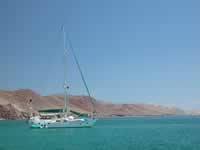
At San Marcos
we carried on with our now usual routine, as we waited for what
we’d hoped would be a good weather window
to cross the Sea to San Carlos. It seemed like, just as we wanted
to make a passage, we suddenly had a lot more weather to worry
about. The crossing to San Carlos would take about 14 hours, requiring
either an overnight passage or a pre-dawn departure. Although the
trip was a logical candidate for an overnight run, we’d been
having a string of afternoon thunderstorms and late-night chubascos.
The chubascos are characterized by lightning and maybe rain coupled
with sudden strong microbursts of wind. At anchor San Marcos, we
were hit with one during the night! If at all possible, it was
an experience we wanted to avoid in open sea.
  
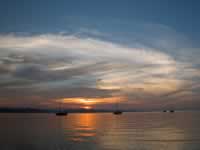 Meanwhile,
as July drew to a close, this year’s crowd of
cruisers were starting to bail out. Suddenly, the radio nets were
reporting that San Carlos’s marinas had no more room. Yikes.
Lisa and Dennis and Paul and Kathi had definite needs to be Stateside,
requiring slips to leave their boats safely. While we could have
made do without one, we’d sure been looking forward to the
luxury of plugging in the air-conditioning. The one thing San Carlos
is known for is being the hottest of the hot. Fortunately for us,
Lady Galadriel had stayed in Marina Real last year, a track record
which enabled her to make reservations for all of us by email.
Still we were concerned, so, anxious not to be caught short, we
packed up our dive stuff, our noodles, and our cribbage boards
and set our departure for 4am the 26th of July. Meanwhile,
as July drew to a close, this year’s crowd of
cruisers were starting to bail out. Suddenly, the radio nets were
reporting that San Carlos’s marinas had no more room. Yikes.
Lisa and Dennis and Paul and Kathi had definite needs to be Stateside,
requiring slips to leave their boats safely. While we could have
made do without one, we’d sure been looking forward to the
luxury of plugging in the air-conditioning. The one thing San Carlos
is known for is being the hottest of the hot. Fortunately for us,
Lady Galadriel had stayed in Marina Real last year, a track record
which enabled her to make reservations for all of us by email.
Still we were concerned, so, anxious not to be caught short, we
packed up our dive stuff, our noodles, and our cribbage boards
and set our departure for 4am the 26th of July.
|